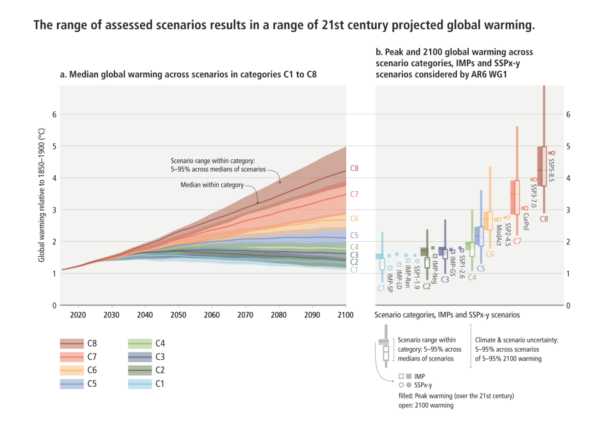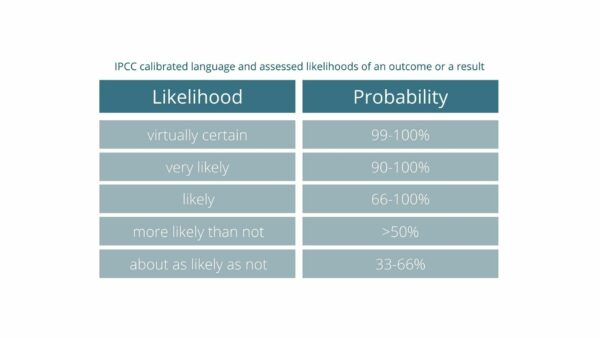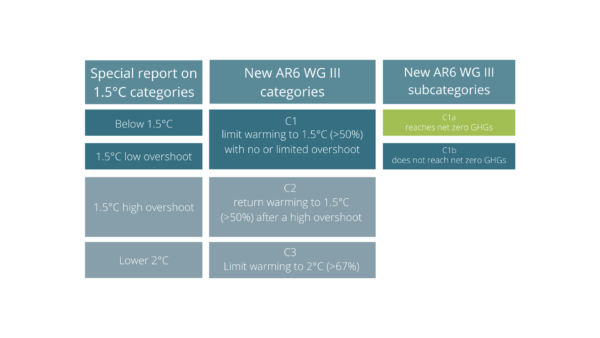New pathways to 1.5°C: interpreting the IPCC’s Working Group III scenarios in the context of the Paris Agreement
Share

The recently released Working Group III contribution to the Intergovernmental Panel on Climate Change’s (IPCC) 6th Assessment cycle provides a synthesis of the most up-to-date science that addresses actions and options for emissions reductions.
This report and its summary for policy makers lands in a fraught policy context, where governments are being confronted with the biggest fossil fuel supply shocks since the 1970s due to the invasion of Ukraine by Russia, bringing energy security to the top of the political agenda.
Meanwhile, the climate crisis accelerates, with a significant emissions gap to 2030 between where we are headed, and what is necessary to keep the Paris Agreement’s 1.5°C warming limit in reach.
The new report contains a myriad of strong policy-relevant messages including that it’s absolutely possible to close the 2030 emissions gap and get on a pathway consistent with limiting warming to 1.5°C, but very urgent action is critical to achieve this. In total, it has assessed 97 pathways that limit warming to 1.5°C, adding to our understanding of the options and conditions for achieving the necessary emissions reductions.
Below, we take a closer look at how 1.5°C compatible pathways are defined in the IPCC AR6 report and why this matters. To do so, we need to start with a bit of history.
IPCC reports and the 1.5°C limit
The IPCC’s role is to be policy relevant but not prescriptive. Its findings lay the foundation for negotiations in the international climate talks and provide guidance for national and regional energy and climate policies.
Prior to the Paris Agreement being signed in 2015, the United Nations Framework Convention on Climate Change (UNFCCC) was working with the aim to “hold” global temperature rise to “below 2°C”. However, scientific research assessed in the IPCC AR4 and AR5 reports showed that this amount of warming would come with grave and dangerous risks for many parts of the world, particularly small island states and least developed countries.
In 2013-15 the UNFCCC conducted its first Periodic Review the ‘hold below 2°C’ goal. It established that a warming of 2°C “could not be considered safe”, and provided justification for the strengthening of the temperature goal. This led to the Paris Agreement’s adoption of the 1.5°C warming limit, with a provision to always “hold” warming “well below 2°C”, reflecting a clear strengthening of the likelihood by which a warming of 2°C should be avoided.
To further enhance the scientific understanding on 1.5°C impacts and mitigation pathways, the UNFCCC requested the IPCC to produce what eventually became the 2018 Special Report on Global Warming of 1.5°C.
The Special Report on 1.5°C provided the first comprehensive assessment of mitigation pathways and energy system transitions consistent with the Paris Agreement’s 1.5°C warming limit. These pathways were defined as having no, or low overshoot, of 1.5°C global warming. These 1.5°C pathways have framed much of the policy debate in implementing the Paris Agreement, providing the basis for key milestones such as coal and fossil gas phase-out dates and 2030 targets, as well as legal judgements, the Glasgow Climate Pact, and the adoption of net zero targets by many countries and companies.
A quick note on pathway likelihoods
The IPCC uses something it calls the ‘calibrated language’ to assess likelihoods. This is particularly important in the context of the analysis of emission pathways, as the uncertainty of the warming response of the climate system to emissions remains very substantial. For any given emission reduction pathway, no matter how stringent, there is only a certain likelihood to limit warming to below a certain level.
A higher than 66% likelihood is what the IPCC calls a likely outcome. The next threshold in IPCC language is very likely, which denotes a higher than 90% likelihood. And then there is the toss of a coin – a 50% likelihood that is called ‘more likely than not’.
Which pathway categories in the IPCC AR6 are consistent with the Paris Agreement?
The IPCC’s AR6 report builds on the Special Report on 1.5°C. It not only includes new emission pathways, but, in an important development from the scientific community, it has made some adjustments to how it classifies them. Here we compare the AR6 approach with the Special Report on 1.5°C:
The AR6 definition of 1.5°C compatible scenarios is the same as the low or no overshoot 1.5°C pathways in the Special Report on 1.5°C: those that “limit warming to 1.5°C in 2100 with a likelihood of greater than 50%, and reach or exceed warming of 1.5°C during the 21st century with a likelihood of 67% or less.” In other words, pathways that are not likely to exceed 1.5°C over the 21st century. Such pathways exhibit a limited overshoot of about 0.1°C or less (median estimate) or no overshoot at all. Median peak 21st century warming of these pathways is 1.6°C, with warming returned to 1.3°C by 2100.
The Paris Agreement long term temperature goal is in the operative part of the agreement, creating legally binding consequence. It is a single goal referencing two temperature levels that can only be understood together: “holding the increase in global average temperature to well below 2°C above pre-industrial levels and pursuing efforts to limit the temperature increase to 1.5°C”. This means pathways compatible with the Paris Agreement long term temperature goal need to be consistent with both of these elements, and, as we will see, also with Article 4.1.
‘Hold well below 2°C’ means that pathways cannot return warming to well below 2°C by 2100 or any other time, but must instead hold warming well below this level throughout the 21st century, if not indefinitely. This means that peak 21st century warming has to be held “well below” 2°C to meet the Paris Agreement’s temperature goal – thereby establishing a clear constraint on any temperature overshoot above the 1.5°C level.
Close reading of the pathway classification shows that the IPCC is taking pains to add further clarity around what “hold well below” 2°C means.
In the AR6 SPM, the IPCC stipulates that 1.5°C compatible pathways in the C1 category – are characterised by a more than 50% chance of limiting warming to 1.5°C and a less than 67% likelihood of reaching or exceeding 1.5°C. But then, in a footnote, it adds that 1.5°C pathways in this category also have a “simultaneous likelihood to limit peak global warming to 2°C throughout the 21st century of close to and more than 90%”.
So decoding the IPCC language tell us 1.5°C pathways are very likely to hold warming below 2°C
The IPCC is making it clear that it’s not a case of either achieving the 1.5°C limit or holding warming well below 2°C – they are part and parcel of the same goal and Paris Agreement compatible pathways should meet both elements.
Net zero greenhouse gases, the Paris Agreement and the AR6 pathways
Article 4.1 in the Paris Agreement sets out a mitigation objectives to peak emissions as soon as possible, and reduce them rapidly thereafter, and to achieve net zero global greenhouse gas emissions in the second half of the century. This needs to be assessed using Global Warming Potential 100 (GWP100), the required metric for emission reporting under the Paris Agreement and UNFCCC. The requirement to achieve net zero global greenhouse gas emissions in the second half of the century provides an additional important constraint on pathways that are consistent with the Paris Agreement.
While all pathways in the ‘below 1.5°C’ and ‘1.5°C low overshoot’ categories of the Special Report on 1.5°C and category C1 of the AR6 report reach net zero CO2 emissions by mid-century, some do not achieve net zero greenhouse gas emissions in the second half of the century.
The AR6 Working Group III has now made net zero greenhouse gases an explicit criterion consistent with Article 4.1 of the Paris Agreement, and established a subcategory C1a, where all pathways achieve net zero greenhouse gas emission around 2070-2075 . These pathways also reach net zero CO2 emissions around 2050, in line with the findings of the Special Report on 1.5°C.
Pathways unlikely to limit warming to 1.5°C
The AR6 report makes a clear distinction between the C1 1.5°C pathways, and what it terms C2 pathways, which in the SR1.5 were called “1.5°C high overshoot” pathways. While the definition remains unchanged, it is made much clearer in the AR6 report that C2 pathways are in fact likely to exceed 1.5°C, similar to ones in the C3 category that “limit warming to 2°C”. They are characterised by large scale carbon dioxide removal deployed in the second half of the century, to “return warming to 1.5°C (>50%) after a high overshoot”.
This matters because of the dangers that come from such a high degree of overshoot. The AR6 Working Group II report is clear, “if global warming transiently exceeds 1.5°C in the coming decades or later (overshoot), then many human and natural systems will face additional severe risks, compared to remaining below 1.5°C (high confidence)”. This is in line with the approach of the Special Report on 1.5°C.
Additionally, pathways in the C3 category, which limit warming to 2°C, actually only have a 2-in-3 chance of not exceeding 2°C. In other words, these are likely “below 2°C” pathways, and see peak warming of 1.7-1.8°C. Warming as high as 2.5°C or more cannot be excluded for pathways in this category. The likely chance to hold below 2°C was how pathways linked to the pre-Paris “hold below 2°C” temperature goal were identified, which was found to be insufficient by the first Periodic Review. It’s therefore clear that they would not satisfy the ‘hold well below’ 2°C textual element of the Paris Agreement’s long term temperature goal.
Why does pathway classification matter?
The new pathway classification C1a in the AR6 report identifies 1.5°C pathways that hold warming “well below 2°C” and reduce greenhouse gas emissions to net zero in the second half of this century. These pathways can be considered consistent with the Paris Agreement objectives outlined in Article 2.1 and Article 4.1.
Of course, not all these pathways are created equal, and different scenario assumptions need to be explored and understood. For example, further work is needed to understand which of these pathways do not rely too much on risky mitigation options (such as unsustainable amounts of bioenergy equipped with carbon capture and storage), and ensure sustainable development for all (the underlying scenario database is available here and here).
But the new IPCC AR6 categories represent a step-change in providing a classification for emission pathways that are fully consistent with the Paris Agreement to better understand the technological and emissions reduction requirements to achieve its objectives. And in this critical moment for climate action, governments and policymakers need to clearly be able to see the parameters within which they need make decisions, in line with the commitments they have made.
















